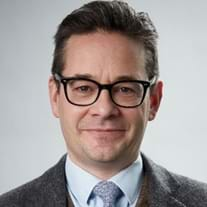The Latest Advances in Pediatric Cancer Research
Dr. Richard Gilbertson discusses his inspiration and the latest advances in pediatric cancer research.
Published January 8, 2018
By Marie Gentile and Richard Birchard


Richard Gilbertson, MD, PhD, Li Ka Shing Chair of Oncology and director of the Cancer Research UK Cambridge Centre, did not initially set out for a career in pediatric cancer — the leading cause of death by disease past infancy for children and adolescents in the United States and Europe.
He “somewhat randomly,” as he says, chose to do his second-year research project on medulloblastoma, the most common malignant brain tumor in children. He was inspired early on by a caring mentor who went above and beyond in attention and enthusiasm and was further determined to pursue this path while getting to know the family of a child with brain cancer.
“One day I went onto the ward, and it was very dark, and all the curtains were closed, and I was told that this child was dying. After inquiring about available treatments, I was told there was nothing to be done. I was incredibly angry with the system that wasn’t able to offer a child a curative treatment.”
Deeply affected by this child’s death, when a friend and fellow medical student challenged him to produce a 15% reduction in mortality of any disease over beers at a pub, Dr. Gilbertson made it his career goal to “produce a 15% reduction in mortality, at least of medulloblastoma in pediatric cancer.”
Discoveries in Medulloblastoma
To that end, Dr. Gilbertson and his lab have made some profound discoveries in medulloblastoma. During the 1980s, medulloblastoma was considered a single disease, with a singular treatment, but “we’ve demonstrated that it is multiple diseases, and those diseases actually have different origins in the nervous system from very specific cell types, and they behave differently.”
This understanding has allowed treatments to be tailored to disease type, resulting in a reduction in the use of radiation therapy, the introduction of new treatments that target the signaling pathways of some forms of medulloblastoma, and insights into other brain tumors including Ependymoma and choroid plexus carcinoma.
His latest research is driven by the question of why cancer is so much less prevalent in children than expected, given that as they grow they have a large burden of cellular proliferation.
“Whereas one in two adults will get cancer eventually, only one in 600 children will, and the math doesn’t add up because children are growing faster than at any other point in their lives,” says Gilbertson.
Understanding the Mechanisms of Cancer Protection
Researchers have long suspected that children’s tissue provides protection against cancer to accommodate this growth, but they lacked definitive evidence or a mechanism for how this works. In a landmark paper published in Cell, Dr. Gilbertson’s lab mapped the functions of cells in numerous organs across the lifetime of mice and introduced tumor-inducing mutations to those cells.
They found that neonatal mouse cells are less likely to undergo tumorigenic transformation compared to adult cells with the same stem cell capacity, supporting the hypothesis that neonatal cells are somehow resistant to forming tumors — extrapolating to humans, this may explain why cancer rates are lower in children than adults.
Understanding the mechanism of this cancer protection has the potential to lead to better treatments not only for pediatric cancers, but adult cancers as well. “That’s critically important because if I can understand (how pediatric cells are protected from cancer), and then we can reactivate that in adult tissues, you’d have a very potent cancer preventative. If we could reactivate the mechanism in pediatric cells to allow them to grow and repair, but not cause cancer — imagine what we could do in adults. You could actually reactivate that pharmacologically with a medicine.”
Dr. Gilbertson is adamant about the need to develop innovative treatments that are proactive and integrated.
“My passion is to see cancers diagnosed as early as possible. Obviously, if you diagnose a cancer earlier, and this is particularly important for children, the required treatment is much less intense. The heroes of future cancer care may not so much be the life scientists, but the physicists, chemists, engineers, and mathematicians. They will be the people who generate innovative and inexpensive devices to detect cancer in its very earliest stages across the population,” he says.
The Need for International Collaboration
Dr. Gilbertson presented his groundbreaking work during the opening Keynote Lecture at the 2018 Sohn Conference: Accelerating Translation of Pediatric Cancer Research, which brought together the leaders in the field of pediatric oncology, and allowed interactions between more established scientists and clinicians with the next generation of graduate students, post-docs, and other young investigators from around the world. This was particularly exciting because due to the rarity of pediatric cancer, clinical trials to develop new treatments require international collaboration. “This disease is life threatening, there’s an imperative to do the best possible research.”
Also read: Improving Survival Rates of Neuroblastoma
